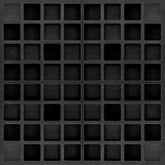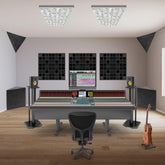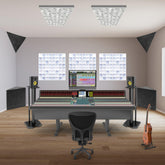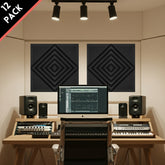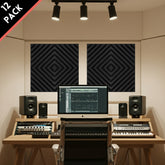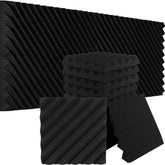The Science of Sound: Understanding Frequency and Amplitude
The Science of Sound: Understanding Frequency and Amplitude

What is Sound?
Definition of Sound
Sound is a type of energy created by vibrating objects. These vibrations cause pressure waves in the air (or another medium), which travel to our ears and are interpreted by our brains as sound. The characteristics of these sound waves determine how we perceive different aspects of sound, such as pitch and loudness.
The Nature of Sound Waves
Sound waves are longitudinal waves, meaning that the particle displacement is parallel to the direction of wave propagation. They consist of alternating compressions (areas of high pressure) and rarefactions (areas of low pressure).
Understanding Frequency
What is Frequency?
Frequency refers to the number of times a sound wave cycles (vibrates) per second and is measured in Hertz (Hz). Frequency is directly related to the pitch of the sound; higher frequencies correspond to higher pitches, and lower frequencies correspond to lower pitches.
Frequency Range of Human Hearing
The human ear can generally hear frequencies ranging from 20 Hz to 20,000 Hz (20 kHz). However, sensitivity varies across this range, with the human ear being most sensitive to frequencies between 2 kHz and 5 kHz.
Octaves and Harmonics
- Octaves: An octave is the doubling or halving of a frequency. For example, if the base frequency is 440 Hz (A4), an octave above would be 880 Hz, and an octave below would be 220 Hz.
- Harmonics: Harmonics are whole-number multiples of a fundamental frequency. They contribute to the timbre or color of a sound, making each instrument or voice unique.
Understanding Amplitude
What is Amplitude?
Amplitude refers to the magnitude of the pressure change in a sound wave and is directly related to the perceived loudness of the sound. It is measured in decibels (dB). Larger amplitudes result in louder sounds, while smaller amplitudes result in quieter sounds.
Amplitude and Loudness
While amplitude is a physical property of the sound wave, loudness is a subjective perception influenced by both amplitude and frequency. The human ear perceives loudness differently across frequencies; for example, we are more sensitive to mid-range frequencies than to very low or very high frequencies.
Decibels (dB) and Dynamic Range
- Decibels: A logarithmic unit used to measure sound intensity. In audio mixing, decibels are used to quantify the level of sound signals.
- Dynamic Range: The difference between the quietest and loudest parts of a sound. Understanding and managing dynamic range is crucial for maintaining clarity and preventing distortion in your mixes.
The Relationship Between Frequency and Amplitude
How Frequency and Amplitude Interact
Frequency and amplitude work together to shape the sound we hear. For example, a sound with a high frequency and low amplitude might be perceived as a faint, high-pitched sound, while a sound with a low frequency and high amplitude might be perceived as a loud, bassy sound.
Perception of Loudness Across Frequencies
The human ear does not perceive all frequencies equally. The Fletcher-Munson curves (equal-loudness contours) demonstrate that our sensitivity to sound varies with frequency and loudness level. This understanding is vital when mixing audio, as it influences how different elements of a mix are balanced.
Practical Applications in Audio Mixing
Equalization (EQ)
Understanding frequency is key to effective EQ. By adjusting the levels of specific frequency bands, you can shape the tonal balance of your mix. For example, boosting low frequencies can add warmth to a track, while cutting high frequencies can reduce harshness.
Compression
Amplitude plays a critical role in compression. Compression reduces the dynamic range of a signal by lowering the amplitude of the loudest parts. This helps to achieve a more consistent volume level across a track, ensuring that no part of the mix is too quiet or too loud.
Panning and Spatial Effects
Frequency and amplitude also influence how we perceive the location of sounds in a stereo field. Higher frequencies are often associated with closer, more direct sounds, while lower frequencies and lower amplitudes can make a sound appear more distant.

Advanced Concepts: Fourier Analysis and Spectral Content
Fourier Analysis
Fourier analysis is a mathematical method used to break down complex sounds into their constituent sine waves. This analysis reveals the spectral content of a sound, showing the frequencies present and their relative amplitudes.
Spectral Content and Timbre
The spectral content of a sound determines its timbre, or tone color. By analyzing and manipulating the spectral content of different elements in a mix, you can achieve a desired sound or effect, such as enhancing the brightness of a vocal or adding warmth to a bass line.
Conclusion
A solid understanding of frequency and amplitude is fundamental to mastering the art of audio mixing. These concepts not only help you shape the sound of individual tracks but also allow you to create a balanced, cohesive mix that translates well across different playback systems. As you continue to explore and apply these principles, you'll gain greater control over your mixes, resulting in a more professional and polished sound.
ABOUT AUTHOR
House Live Engineer of Free Bird, a live house with the history of South Korea's indie music scene.
Single album/Regular album/Live recording, Mixing and Mastering experience of various rock and jazz musicians







